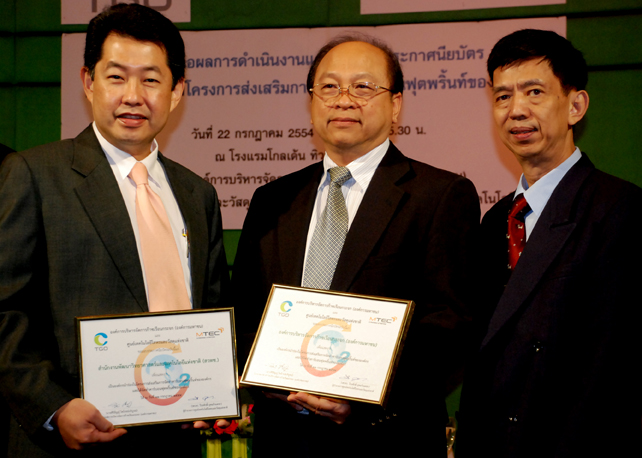With increased global warming, it is impossible to deny that continued human activities are the main cause. These activities range from energy consumption, industrial development and expansion, transportation, to deforestation as well as the destruction of natural resources. Certainly, all of this has affected humanity. In order to solve the
problem, the concept of a “Low-Carbon Society” has come into existence. It principally focuses on greenhouse gas reduction processes or activities that can be done in daily life.

The Thailand Greenhouse Gas Management Organization (Public Organization), or TGO, has collaborated with the NSTDA (The National Science and Technology Development Agency) and ten pilot organizations from the government sector, the private sector, and academic institutions to launch the Carbon Footprint for Organization (CFO) project. On 22 July, 2011, Dr. Sirithan Pairoj-Boriboon, Director of the TGO, and Assoc. Prof. Dr. Werasak Udomkichdecha, Director of the National Metal and Materials Technology Center (MTEC), presented a certificate to Dr. Narong Sirilertworakul, Executive Vice President of the NSTDA. The NSTDA is the pilot organization in the CFO project while MTEC is a co-host of the project.
What is Carbon Footprint for Organization (CFO)?
Carbon Footprint for Organization is a method to assess the levels of greenhouse gases emitted from all activities done by organizations, which is calculated in quantities of carbon dioxide measured in kilograms or tons. As for Thailand, CFO is hardly seen. TGO has thus joined forces with the NSTDA and ten pilot organizations from the government sector, the private sector, and academic institutions to embark on the Carbon Footprint for Organization (CFO) project (signed on 18 November, 2010) with the purpose of setting approaches or criteria to assess CFO. The criteria will then be applied as guidelines to assess greenhouse gas emissions resulting from activities of organizations in Thailand.
CFO is not limited to any size or particular attributes of activities. CFO can be undertaken in government organizations, academic institutions, or businesses. Not only can CFO lead to returns in terms of costs (because it can save energy in the working system), but it can also express corporate social responsibility as part of an attempt to bring solutions to global warming and reduce greenhouse gas emissions from organizational activities.
How to Measure the Extent of CFO?
The carbon footprint measurement is used to calculate the total amount of greenhouse gas whose scope needs to be considered as follows:
Scope I: The calculation for direct emissions from organizations’ direct activities. Examples include the use of LPG and other fuels in laboratories and the use of chemicals such as refrigerants, substances used in laboratories, chemicals used in wastewater treatment systems, transportation by organization-owned vehicles etc.
Scope II: The calculation for indirect energy emissions such as the use of electricity that is not self-produced.
Scope III: The calculation for other indirect emissions such as employees’ travel which excludes organization-owned vehicles, the use of other materials or of water etc.
What benefits can be gained from CFO?
Assessment in CFO will help categorize the causes of greenhouse gas emissions, thus leading to the determination of management approaches to effectively cut down on CO2 emissions at the organization level. Meanwhile, the organization’s image will be enhanced from participating in a reduction of global warming for the benefit of the whole country. CFO is likely to become the standard accepted by many organizations since it reflects their social responsibility.
Meanwhile, the NSTDA has been implementing its “Green NSTDA” activity to promote energy savings and an environment conservation policy. During the first three quarters of 2011, the NSTDA has attained an average decrease of 8.3% in energy use. Also, it has initiated the project of “Three Paper Pages for One” for children, thus reducing the amount of paper-producing resources equal to 21 trees, nearly 5,000 kWh of electricity, 38,319 liters of water, or 8.5 kilograms of chlorine. The reduction means a decrease in CO2 of 4,412 kilograms.
